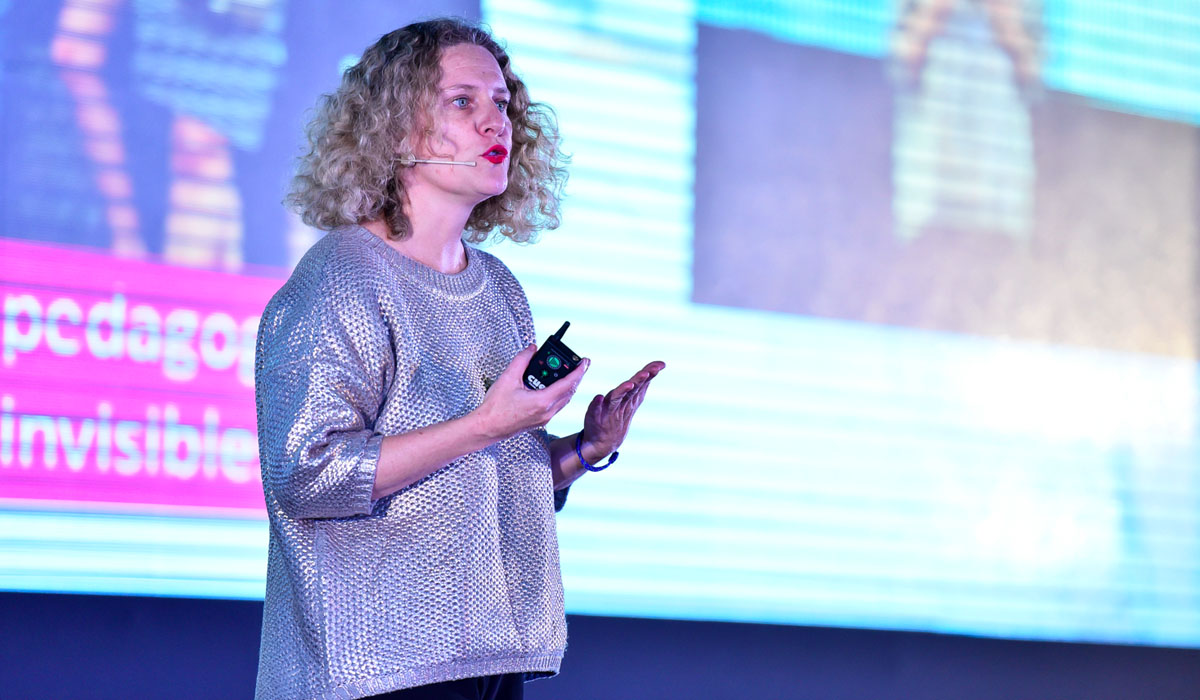Interviewed by the Observatory of Educational Innovation
María Acaso, Latin-American leader of the rEDUvolution and professor at Universidad Complutense de Madrid, talked to us about the difficulties of generating innovation in education. She also discussed about Sexy Pedagogy and Art Thinking, in other words, the need to incorporate pleasure as the core component of education, and creativity as the primordial quality for teachers.
Observatory: What are the difficulties of innovating in teaching?
María Acaso: Each country’s specific situation should be analyzed. In Spain, for example, the teacher training faculty has one of the lowest passing scores, so ultimately people who teach do so because they don’t know what they want to do, because they couldn’t find anything better to do. I find this approach nefarious. We are always talking about Finland, but the truth is that what Finland does is select the best students so they can go into education, not engineering or suchlike, but education. Being a teacher is a profoundly intellectual job that requires extremely high capacities at every level. It’s a job that everyone who is a teacher knows is exhausting. It’s a very political job, and, therefore, that’s where we need the best people. And these people need to be well trained.
Moreover, what I see in the teacher-training curriculum, or master’s for secondary education, is that they are completely outdated for what is required of a teacher in the 21st century. There are subjects such as: “Didactic unit scheduling III”; this course is pointless now. You need to inject humor, substance, power dynamics, disruptive assessment systems. In other words, teacher training overall needs to be radically different and also keep on changing. In other words, it can’t be a curriculum that will be relevant for the next 10 years.
The teacher-training curriculum its completely outdated for what is required of a teacher in the 21st century. Teacher training overall needs to be radically different and also keep on changing.
Observatory: How important is creativity in a teacher?
María Acaso: I think that the most important competency for a teacher to have is to be creative. For me, it is almost more important than being knowledgeable in the subject. If you have a creative teacher, who is capable of designing all these different learning spaces, then you’ve already won 90% of the battle.
But it would also be interesting to reformulate what creativity means in the 21st century. In the 21st century, creativity isn’t the creativity of the 19th-century genius who would get up in the middle of the night to paint. Right now, creativity is the remix, it’s remixing. And remixing isn’t copying. You are not copying someone’s idea, because what you’re doing is appropriating that idea. You link this idea with your thoughts and you create another new idea. This leads me to a concept I like a lot, which is viewing the teacher as a DJ: DJs take other people’s songs and their contribution is the combination of songs on their playlist. I think that nowadays, as teachers, we need to work in the same way. Teachers take content from different people and their contribution is how they combine it in the class itself. We have to understand creativity rather as this process of creating new ideas based on other people’s ideas, and that our contribution is the combination of others’ ideas.
I think that the most important competency for a teacher to have is to be creative.
Observatory: How can art be used to educate disruptively?
María Acaso: Actually, the new concept I am developing is called Art Thinking, which is drawn only to some extent from Design Thinking, since it is larger. Art thinking would be like using art to transmit any subject, understanding that art incorporates dynamics, performance, installations, images… So, it would mean training teachers in these possibilities offered by the arts, not just visual arts, but also literary arts, musical arts, everything that concerns divergent thinking, in order to teach their classes in a methodologically different, fashion. I always use it. Every time I teach a seminar, or a workshop, I look for different materials and don’t know what the outcome will be. But, generally speaking, the outcome is always better than before. Sometimes I’ve used white sheets, at others squid, and others doughnuts. And this different material inspires astonishment, it works well because people don’t get bored. These materials excite people intellectually, which makes the learning process far more interesting.
Observatory: How else can creativity make a course more engaging?
María Acaso: Something I love doing is to use naming in pedagogy. I think that what we need to do to address pedagogy in the 21st century is to take concepts from other disciplines and transfer them to pedagogy. Naming is a marketing discipline that consists of designing names. Why do banks have such interesting names? Why do chefs give their dishes such interesting names? So, why to educators use such boring names? One of the values I think creative teachers have is naming their classes, which is very important. These names have to be as interesting and as exciting as names in advertising.
For example: In Madrid we had a biology center that nobody went to, which was called the National Biology Center. They changed its name and called it Faunia, and now you have to queue up to get in on a Sunday. In other words, names make you want things, desire things, and that’s what we as teachers need to achieve. So, all my lectures, all my concepts, and those that teachers must develop, should be linked to a name that catches your attention. “Sexy Pedagogy”, right now I can’t remember when I thought that up, but it works very well. You say “Sexy Pedagogy” to someone and they are already smiling. And that makes you think: What does this mean? So, astonishment works and from there, knowledge starts. If I call a conference “Methodological strategies for education in the 21st century”, everyone would fall asleep.
Images:
2do. Congreso Internacional de Innovación Educativa (2015). Retrieved from: https://www.flickr.com/photos/ciietec/ page4 aulaplaneta (2014). María Acaso llama a los profesores a emprender la revolución educativa en rEDUvolution. Retrieved from: http://www.aulaplaneta.com/wpcontent/ uploads/2013/12/noticia114a.jpg mediacionartistica (2015). Foto María Acaso. Retrieved from: https://mediacionartistica.org/2015/02/11/programa-arteeducacion-porprimera- vez-en-arco-2015-entrevistacon-maria-acaso/
This article from Observatory of the Institute for the Future of Education may be shared under the terms of the license CC BY-NC-SA 4.0 
)
)




)